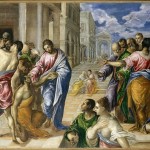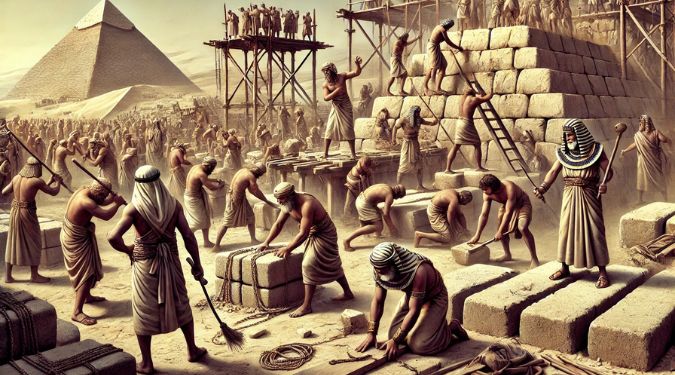Recently I had the opportunity to reflect a bit on the the story of Jesus healing the man born blind in 9th chapter of the Gospel of John. You might remember that’s the story where Jesus and his disciples encounter a man blind from birth. Jesus spits on the ground and daubs the mixture of dirt and spit onto the man’s eyes and tells him to wash himself in the Pool of Siloam. The story does not stop there, but that’s the gist of it.
So, what’s up with the spit and the mud? To find out, I turned to the original Greek text of the reading, and to words of some ancient Church Fathers. I was in for a surprise.
I found out first that this story is not about the blind man’s sin, and Jesus does not perform the miracle to convince him of his sin, or of his blindness. The blind man knows that he is blind. When his disciples asked him, “Rabbi, who sinned, this man or his parents, that he was born blind?” Jesus answered, “It was not that this man sinned, or his parents, but that the works of God might be made manifest in him.” In fact, the entire Gospel of St. John is structured around seven miracles or “signs”, and this was the sixth sign of seven meant to glorify God.[1]

Secondly, a close reading of the passage shows that Jesus did not put “mud” into the eyes of the blind man at all, but rather, “clay”. The Greek word used in this passage is πηλὸν, “pelon” (transliterated from the original Koine Greek), the accusative form of πηλός. Its primary meaning is “clay”, as in that used by a potter. The word is used the same way in the Septuagint (the version of the Old Testament in Greek favored by the authors of the New Testament) Isaiah 29:16; Isaiah 41:25; Nahum 3:14; Sirach 33:13, Sirach 38:30, Wisdom 15:7 and in the New Testament in Romans 9:21.[2] This “clay” reminded the early Church that God created man, including his eyes, from clay. [3]
Says St. John Chrysostom [347-407 AD]:
“And why used He not water instead of spittle for the clay? He was about to send the man to Siloam: in order therefore that nothing might be ascribed to the fountain, but that you might learn that the power proceeding from His mouth, the same both formed and opened the man’s eyes, He spat on the ground; this at least the Evangelist signified, when he said, And made clay of the spittle.”[4]
Or in another place, St. John Chrysostom says:
“He then confirms His words by deeds: When He had thus spoken, He spat on the ground, and made clay of the spittle, and anointed the eyes of the blind man with the clay. He who had brought greater substances into being out of nothing, could much more have given sight without the use of any material: but He wished to show that He was the Creator, Who in the beginning used clay for the formation of man. He makes the clay with spittle, and not with water, to make it evident that it was not the pool of Siloam, whither He was about to send him, but the virtue proceeding from His mouth, which restored the man’s sight.”[5]
Lastly, the passage says that Jesus did not fill the blind man’s eyes with mud, but rather, he anointed the man’s eyes with the clay.

Here the Koine Greek word used is, “epechrisen”, which literally means “he anoints on.”[6]
Says St. Augustine [354-430 AD]:
“Our Lord spat upon the ground, and made clay of the spittle, because He was the Word made flesh. The man did not see immediately as he was anointed; i.e. was, as it were, only made a catechumen. But he was sent to the pool which is called Siloam, i.e. he was baptized in Christ; and then he was enlightened.”[7]
Summary
We can trust St. Augustine that this passage can be seen as pointing toward baptism, or about preparing for baptism, or coming to a deeper appreciation about our baptism. In the Catholic Church, people preparing for baptism are called “catechumens” and the process of preparing for baptism is called the “catechumenate”.
While one will certainly come to a greater understanding of one’s state before God during any catechumenate, the catechumenate is not about Jesus making us feel dirty so that we will want to be clean. Instead, it’s about His power to heal and about revealing to us the power of His grace. He anoints us with clay and forms new, spiritual eyes in us.
Footnotes
[1] There are seven signs in the “Book of Signs” (John 1-12):
- Changing water into wine in John 2:1-11
- Healing the royal official’s son in Capernaum in John 4:46-54
- Healing the paralytic at Bethesda in John 5:1-18
- Feeding the 5000 in John 6:5-14
- Jesus’ walk on water in John 6:16-24
- Healing the man born blind in John 9:1-7
- Raising of Lazarus in John 11:1-45
[2] Thayer’s Greek Lexicon, http://biblehub.com/greek/4081.htm, retrieved October 18, 2014.
[3] Gen. 2:7
[4] St. John Chrysostom, Homily 57 on the Gospel of John, http://www.newadvent.org/fathers/240157.htm
[5] Catena Aurea: Commentary on the Four Gospels, Collected out of the Works of the Fathers, Vol. IV, Part I, St. John, By St. Thomas Aquinas, http://www.catecheticsonline.com/CatenaAurea-John9.php, Retrieved October 18, 2014.
[6] Thayer’s Greek Lexicon, http://biblehub.com/greek/2025.htm, retrieved October 18, 2014.
[7] Catena Aurea: Commentary on the Four Gospels, Collected out of the Works of the Fathers, Vol. IV, Part I, St. John, By St. Thomas Aquinas, http://www.catecheticsonline.com/CatenaAurea-John9.php, Retrieved October 18, 2014.
References
- A Greek-English Lexicon of the New Testament and other Early Christian Literature, 3rd edition, Revised and edited by Frederick William Danker, The University of Chicago Press, Chicago, 2000.
- Thayer’s Greek Lexicon, http://biblehub.com/greek/4081.htm, retrieved October 18, 2014.
- The Gospel of John, Chapter 9, in the original Koine Greek: http://www.scripture4all.org/OnlineInterlinear/NTpdf/joh9.pdf
- Homily 57 on the Gospel of John, St. John Chrysostom, http://www.newadvent.org/fathers/240157.htm
- Catena Aurea: Commentary on the Four Gospels, Collected out of the Works of the Fathers, Vol. IV, Part I, St. John, By St. Thomas Aquinas, http://www.catecheticsonline.com/CatenaAurea-John9.php





Wonderful scholarly explanation that has a deep inner meaning of this miracle